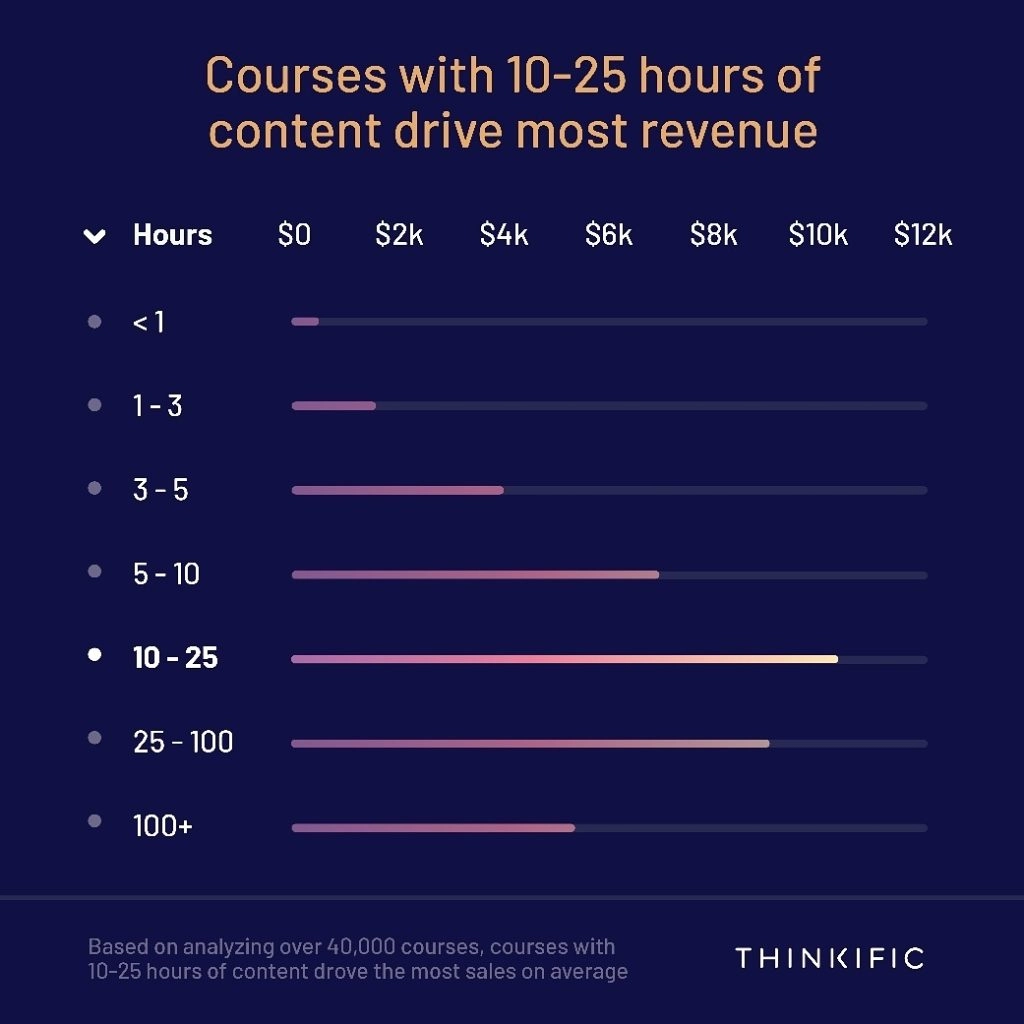What’s the best course length when you teach online? It’s become a truism that you need 10,000 hours of practice to get really good at something. But that seems a bit high.
So, if not 10,000 hours, how long should you make your online course? How long should you make each section? Each video?
We’ve compiled statistics at Thinkific to find out which average course lengths are the most profitable. But that’s just one part of the equation. Before you even plan your online course, you need to determine your goals.
Launch your online learning product for free
Use Thinkific to create, market, and sell online courses, communities, and memberships — all from a single platform.

How teaching goals affect online course length
You’ve got an idea for an online course, and you’re sketching out a course plan. If it’s a subject you’re passionate about and want to share, you may find it hard to set a cap on how many hours students spend learning.
If you run an online course business—meaning, you earn a significant portion of your income teaching online courses—it’s tempting to pump out hours and hours of course content. After all, more course content means more money, right?
Not necessarily. Remember, customers have their own interests in mind—they want a thorough education in the subject, but they don’t want to spend a lifetime learning it.
Say your course, “Introduction to Music Theory,” is 120 hours long, but your competitor’s is 48 hours. You could end up missing out on a swath of students eager to write their first orchestras ASAP.
However, don’t cut down your course just yet. Skip over the essentials of sight reading, and your music students may demand a refund.
But get bogged down in the details, and they may also jump ship for a faster solution. Your goal should be to balance time efficiency with thoroughness.
If you are a corporate trainer, your goal is to get students educated in the subject matter as soon as possible. It’s a cliche, but time really is money. The more time your client—who is also your students’ employer—spends with under-trained staff, the more time (and money) they waste.
In this instance, set concrete learning outcomes—proficiency with a certain app, for instance—that you and your clients will agree to. Then, find the fastest way to reach those outcomes.
The more efficient your course, the happier your client. That can lead to referrals and repeat business.
The most profitable online course length
Let’s cut to the chase. Based on what we’ve seen at Thinkific, the most profitable course length on average is between 10–25 hours.
Just below that, 5-10 hour courses are about 75% as profitable. And at the higher range, longer courses—25–100 hours—are slightly less profitable than those.
Says who?
Says us. We collected information on 40,000 Thinkific course creators to get our numbers. On average, creators with 10–25 hour courses earn revenue of $10,000.

If you’re planning your first online course, you could do worse than set a runtime between 10 and 25 hours. That being said, caveat venditor. While this data is useful in providing a broad picture of course lengths and how they perform, we want to make one thing clear: course length is not a predictor of revenue growth.
Caveats to using the most profitable online course length
While based on our data, 10–25 hours is a good goal, it isn’t the be-all and end-all of course lengths. What matters more than your course length, is the value and transformation you’re providing through your course. Here are some factors to consider in deciding on course length.
Rarity of online course material
If you’re teaching a niche subject that hasn’t been covered in detail elsewhere online, you have less competition for your students to benchmark against. They will have less decision-making to do in comparing options around the time investment required to get to their desired result.
So, if you firmly believe your students need 30 hours of instruction before they start breeding race pigeons, then by all means, craft a course that spends 30 hours teaching them.
However, no competition doesn’t mean you should throw caution to the wind and draw out your course as long as necessary. Stay focused on your student’s desired outcome, and how you can provide the fastest path to success.
On the other hand, if your target audience googles “how to breed racing pigeons,” and can find all the information they need quickly on, you’ll need to factor in the increased supply of competitive offering. In this case, course length can become an even more critical competitive advantage. Your course will need to be both more thorough and more efficient—taking less time and energy than it would take them to sift through competing resources, research the topic in depth, and teach themselves.
Complexity of the subject matter
Sometimes, you just can’t rush. You can only condense information so much before it starts losing value. If that’s the case, focus on teaching your subject thoroughly, rather than sacrificing information to fit in the 10–25 hour sweet spot.
If your subject runs especially long—it turns out you need 50 hours to cover the basics of pigeon breeding—and you want to get your course length closer to 10–25 hours (maybe to be in line with the competition), consider breaking your subject up. You could have an eight-hour course on the history of racing pigeon breeds and their genetics; a twelve-hour course on properly housing, feeding, and training pigeons; and so on.
On the flipside, if the subject you’re teaching only needs 5 hours of instruction, don’t stuff the course with unnecessary information in order to reach 10 hours. Your students won’t appreciate the dead weight, and you’ll lose them.
In this case, use brevity as a selling point—or make your short course a free introduction to the subject, and encourage students to upgrade their knowledge with paid courses. On Thinkific you can use our Mini Course Template to create a course that acts as a free lead magnet, giving them a taste of what else you offer for a fee.
Competing online courses
Research competing courses before planning and launching your own. The places your competitors fail are areas where you can excel. Look for:
- Knowledge gaps. Are your competitors failing to cover an important topic? You could make it a centerpiece of your own course.
- Done-to-death subjects. Find new angles or new ways to pass on your knowledge. If you’re a woodworker, and there are 57 courses on building birdhouses, do one on building bat houses instead.
- Out-of-date topics. Especially when it comes to tech, the field of knowledge is always changing. You could outdo your competitors by teaching the latest version of a programming language, or the most up-to-date online marketing hacks.
- A really successful course. If there’s a truly standout competitor dominating your niche, study what they’re doing. What helps them outshine the rest? How can you do it better?
Required course lengths for continuing education
If your students are pursuing continuing education, or meeting the requirements of a college or professional association, you’ll need to take that into account when setting your course lengths.
For instance, depending on the state where they operate, REALTORS™ are required to complete a certain amount of continuing education every year. If that’s your target audience, you may want to tailor your courses to match.
How long should videos for online courses be?
You may be able to ramble on for hours about your subject of choice, but that doesn’t mean your educational videos should be feature-length productions.
In fact, unsurprisingly, shorter videos are the most effective at keeping students engaged.
A study by SumoMe found that:
- User engagement drops off sharply after about two minutes. It doesn’t seem to matter whether your video is 26 seconds long, or exactly two minutes—engagement stays about the same.
- Between three and six minutes, engagement really goes downhill.
- Between six and 12 minutes, engagement levels out.
- After 12 minutes, engagement once again begins to drop.
Key takeaways:
- If your video content is short, make sure it clocks in below two minutes.
- If it’s long, make sure it’s longer than six minutes—but if it’s longer than twelve, proceed with caution.
In order to keep viewers engaged, you may need to break videos down (divide a four-minute topic into two separate sub-topics) or build them up (combine two three minute topics to make a longer six-minute video.).
As always, keep the students’ interests in mind. If, without sacrificing important information, you absolutely cannot shorten your video from two minutes thirty seconds to two minutes even, keep the original length. It’s not worth making a low-quality video just for the sake of engagement statistics.
How long should online course lessons be?
When it comes to ideal lesson lengths for online courses, the matter is less cut and dry than it is with video.
For starters, the ideal timespan in which to fit a lesson isn’t just relevant to online course creators. Teachers of every type struggle to choose the best lesson length to keep students’ attention. In the case of public school, this may depend on age; since you’ll likely be teaching adults, you need to take different factors into consideration.
For instance: Are your students learning by choice, or by force? If they’re already interested in a subject, and they’re learning about it in order to enrich their personal lives, they may be more motivated to set aside large chunks of time for lessons.
On the other hand, if they’re taking your course in order to meet professional or corporate requirements, they’re less likely to be passionate about the subject you’re teaching. In that case, you may wish to stick to shorter lesson lengths, broken up with quizzes or exercises.
5 ways to keep online students’ attention
The science of attention span is complex and ever-evolving. However, there are some simple techniques you can use to keep your students engaged, no matter how long your online lessons are.
- Make them laugh.
Students pay more attention to teachers who slip humor into their lessons. You don’t have to be a comedic genius; even a few corny puns or “dad jokes” may be enough to capture their attention.
- Shake it up every 15 minutes.
Changing things up at intervals helps break up the lesson and keep students listening. Try sharing interesting anecdotes and asides, using new forms of media—a video or image—or a question (“How does X apply to you?”).
- Make abstract ideas concrete.
Breeding racing pigeons and building bat houses are both concrete examples of online course topics. Specific examples—whether real or imaginary—help students latch on to a subject.
- Motivate them.
Your students may have an abstract idea of why they want to learn a subject. Show them the real-life outcome of what they’re learning. “Learning this HR software will make your job easier,” or “Building bat boxes can help support declining populations of the little brown bat (Myotis lucifugus) in your area.”
- Step out of your modal comfort zone.
When a lesson is multimodal, it uses different formats to educate students and keep them engaged. If you’re most comfortable presenting slideshows online, try presenting some lessons with live action video or animations. Or, instead of simply presenting a piece of information, give students what they need to research it and draw their own conclusions.
In sum, while 10–25 hours seems to be on average the most profitable online course length for Thinkific users, keep this in mind purely as a guidepost, not a rule. There are a lot of unique factors to take into account when planning the length of your online course.
Launch your online learning product for free
Use Thinkific to create, market, and sell online courses, communities, and memberships — all from a single platform.








